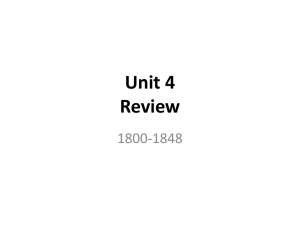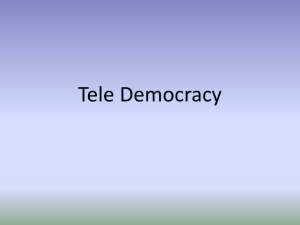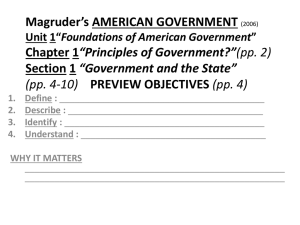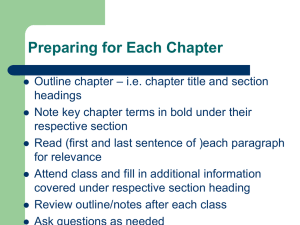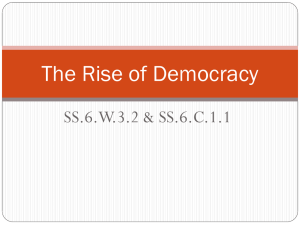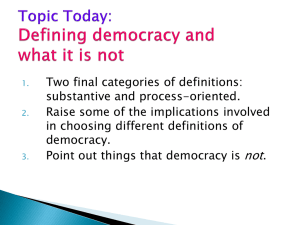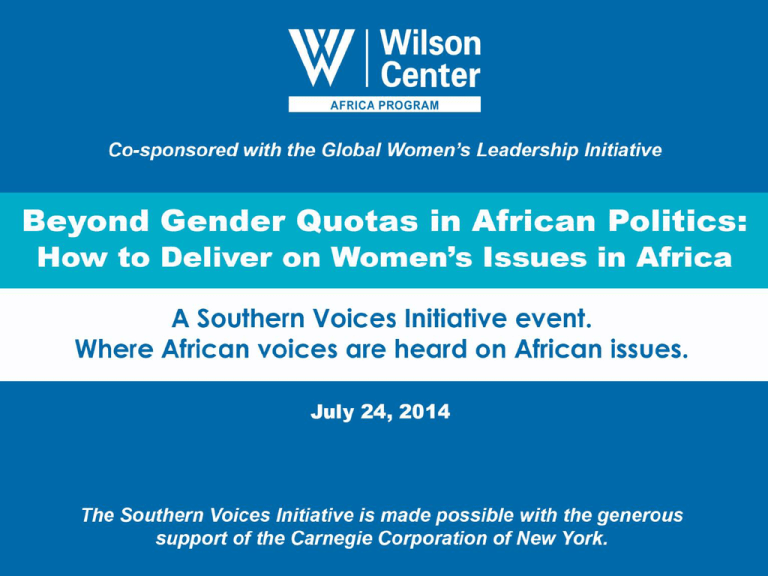
Outline of discussion
A. Brief overview- the discussion on women’s political participation
B. Women’s access to power and decision-making in Africa
a) Progress
b) Current outlook
c) Gender Quotas and the question of ‘what impact’?
d) Persisting challenges to women’s participation
C. Engendering political participation in Africa: Recommendations
Women’s inclusion in political processes:
The discourse
Underlining the discourse on women’s participation are the principles of equal rights,
equal opportunities, and representative governance
Beyond this, the essence of women’s participation in decision-making has been
highlighted by various reports;
“When more women are elected to office, policy-making increasingly reflects the
priorities of families and women’. In Rwanda and South Africa, an increase in
the number of female lawmakers led to progressive legislation on land
inheritance and reproductive rights.”
-World Bank 2014
Political participation has been made an indicator of the MDG 3. This emphasizes the
need to address the problem of women’s political marginalization all around the world.
However, women’s political participation is one indicator on which progress has been
slow and behind target- (UN Women)
Women’s
Political
Participationin
in Africa
Africa
Women’s
Political
Participation
• The right to political participation is recognized all across Africa
• However, like most other parts of the world, access to power & decisionmaking (unlike the right to vote) is practically unequal for men and
women at various levels of power
• There is limited comprehensive comparative data on access to power
between males and females on the continent but overall, there are far
fewer women in positions of authority as compared to men
• This notwithstanding, it needs to be recognized that Africa has made
some impressive progress in advancing women’s access to power within
its relatively short history of democratic governance
Current
Current Outlook-Different
outlook: Different levels
levels of
of power
power
• 2 Sitting Heads of State - Liberia, Central African Republic
– 1 President lost her seat (Malawi) and 1 Head of Government also lost
her position (Senegal)
• 11 Speakers of Parliament (as of January 2014) - Botswana,
Equatorial Guinea, Gabon, Madagascar, Mozambique, Rwanda,
Uganda, Swaziland, South Africa, Tanzania, Zimbabwe
• 5 (out of 52) Permanent Representatives to the United Nations Liberia, Niger, Seychelles, Sierra Leone, Zambia
– There are a total of 31 women of the 193 Permanent Representatives at
the UN as at June 2014 (Source: UN)
Women in Ministerial Positions-(As at 1ST Jan. 2014)
Women in ministerial positions (Jan 2014)
Percentage
Range
No. Of
Countries
4O% and above 1
30-39%
20-29.9%
8
14
Percentage of
total no. of
countries
Names of countries
2.1%
Cape Verde
17.3%
Rwanda, South Africa, Burundi, Tanzania, Kenya, Uganda,
Malawi, Madagascar
30.4%
10-19.9%
21
45.7%
Below 10%
2
4.3%
Mozambique, Gambia, Swaziland, Eritrea, Nigeria,
Seychelles, South Sudan, Ghana, Benin, Lesotho, Namibia,
Togo, Liberia, Comoros
Angola, Gabon, Senegal, Sudan, Cote D’Ivoire, Sao Tome
and Principe, Chad, Zambia, Cameroon, Guinea, Burkina
Faso, Ethiopia, Mauritania, Niger, Botswana, Algeria, Mali,
Zimbabwe, DR Congo, Egypt, Sierra Leone
Equatorial Guinea, Mauritius, Somalia, Djibouti, Tunisia,
Libya
Source: www.ipu.org
Representation
in NationalParliaments
Parliaments
Representation
in National
(lower/single house)
(lower/single house)
Percentage
Range
40% and above
Number of
Countries
List of Countries
Rwanda, Seychelles, Senegal, South Africa
4
Proportion of
Countries
8%
Mozambique, Angola, Tanzania, Uganda, Algeria,
Zimbabwe, Cameroon, Burundi
30-39%
20-29%
8
12
16%
Tunisia, Ethiopia, Lesotho, South Sudan, Namibia,
Mauritania, Sudan, Equatorial Guinea,
Madagascar, Eritrea, Guinea, Cape Verde
24%
10-19%
0-9.9%
19
7
Kenya, Burkina Faso, Mauritius, Sao Tome and
Principe, Togo, Morocco, Malawi, Libya, Gabon,
Chad, Somalia, Guinea-Bissau, Niger, Djibouti,
Sierra Leone, Liberia, Ghana, Zambia, DR Congo
Botswana, Mali, Cote D’Ivoire, Gambia, Benin,
Congo, Nigeria, Swaziland, Comoros,
Source: www.ipu.org
38%
14%
Representation
in National
Parliaments(cont’d)
Representation in national
parliaments-chart
(continued)
Progress over the years(1997-June 2014)
Progress over the years (1997 – June 2014)
Electoral outcomes in SA & Malawi in the last few month/weeks saw a drop from 44.8% to 40.8% and
22.3% to 16.7% respectively
Sub-Saharan Africa’s performance in relation to
Outline
of discussion
other
regions
Factors
contributing
to
progress
Factors contributing to progress
• Global and regional efforts providing a framework for demanding
women’s improved access to power and decision-making
• Strong Political will (‘presidential patronage’)
• Efforts of strong women’s movement/civil society (South Africa,
Uganda)
• Adoption of gender quotas by the state and political parties
Adoption
of Gender
Quotas
Adoption
of gender
quotas in
Africa
•
•
•
•
•
The nature of gender quotas adopted
vary from country to country. Some
have a combination of various forms of
quotas.
Zimbabwe, Kenya, South Africa have
both legislated candidate quota and
voluntary party quotas.
Some mandated quotas are also
applied either at the national or subnational level or both (Rwanda vs South
Africa)
Similarly, the impact of quotas on
women’s political participation has
varied from country to country
Quotas have in some cases led to
impressive increases in women’s
participation
in Africa
The Different Forms of Quotas Adopted
Different forms of quotas adopted
Type of
Quota
Reserved Seats
Legislated Candidate
Quotas
Voluntary Political
Party Quotas
No Quota adopted
List of
Countries
•
•
•
•
•
•
•
•
•
•
•
•
•
•
•
•
•
•
•
•
•
•
•
•
•
•
•
•
•
•
•
•
•
•
•
•
•
•
•
•
•
•
•
•
•
•
•
•
•
•
•
•
•
Morocco
Algeria
Niger
South Sudan
Uganda
Kenya
Somalia
Djibouti
Tanzania
Burundi
Zimbabwe
Swaziland
Sudan
Eritrea
Cape Verde
Senegal
Mauritania
Togo
Burkina Faso
DR Congo
Angola
Rwanda
Libya
Tunisia
Egypt
Lesotho
Guinea
Mauritius (local
level, not more than
2/3rds of the same
sex, not more than 2
from same sex)
Mali
Cote D’Ivoire
Cameroun
Malawi
Namibia
South Africa
Botswana
Mozambique
•
Ghana
Nigeria
The Gambia
Guinea-Bissau
Liberia
*Sierra Leone
*Mauritius
Benin
Gabon
Equatorial Guinea
Congo
CAR
Chad
Ethiopia
Zambia
Madagascar
Sao Tome and
Principe
Seychelles
Quotas
in Africa-Assessing
the impact
Quotas
in Africa:
Assessing the impact
The Outcomes
The Dangers
•
Overall, quotas have opened up access to
power and decision-making for more
women
•
•
The increased presence of women in
parliament has been linked to positive
legislation affecting women (e.g. the role of
female MPs in Rwanda in championing the
gender-based law (including courting
support from male colleagues)
•
Impact on women’s contribution to
parliamentary debates (esp. more vocal &
better articulation of women’s issues, etc.
{eg. Tanzania (Yoon 2011)}
•
Influence on a culture of acceptance of
female leaders
•
Female leaders as role models
•
Quotas as glass ceiling/Limits
Implementation challenges in some
countries (eg. incomprehensive
modalities for implementation, e.g.
Kenya)
•
Women being pushed away/shunning
from competitive seats to
quota/reserved seats only
•
The question of impact (descriptive vs
substantive representation)
The discussion on IMPACT (Descriptive vs.
Outline of discussion
substantive
representation)
• The adoption of gender quotas as a means for expanding participation for
women (quantitative descriptive rep)
• But the issue of how this translates into impact is often raised
• The question however is ‘what impact’ are we looking at?
• Impact as in policy outcomes, overall contribution to the governance process,
or which?
• Are we looking only at immediate tangible outputs?
• Impact on who? Women leaders assume the role of a dual representative - how
about their contribution to other issues that affect other members of society?
The
‘impact’
question
(cont’d)
The discussion on IMPACT (continued)
The question of impact is often oversimplified
• There are institutional complexities and political dynamics
• -legal procedures, party allegiances, etc.
Are we looking at impact of female leaders on women and
women’s issues only?
– OR their overall contribution to society
• The question also puts female leaders under some
unbalanced scrutiny (what about the leadership of male
colleagues)
Outline ofchallenges
discussion
Persisting
to women’s participation
• Progress has been made but negative socio-cultural attitudes and norms persist
“The values and norms of society are more essential to the democratic integrity
of a country than the institutional barriers written in a constitution.”
-Robert Dahl on the American system
•
The notion and ideas of gender equality have become very popular, but
attitudes are yet to change completely.
• Low participation at other levels of power:
• Local government structures
• Political party structures
• Gendered assessment of women leaders and the problem of over-generalization
Engendering women’s political participation in Africa:
Outline of discussion
Recommendations
National level actors
There is the need to address the socio-cultural challenge
-Intensify civic education emphasizing the equal capabilities of women to
lead
-Socialize the next generation of Africans on values as equality and
individual differences through schools curricula
• Getting more capable women to go into the public arena
-Sensitize women on the need to come out and get involved at the various levels (there is
no lack of capable or well-resourced women to run for public offices)
Engendering women’s political participation in Africa:
Cont’d
Recommendations (continued)
Non-Governmental organizations
1. Deepen engagement with political parties (this has often been a
delicate issue but needs to be balanced)
– Support structures such as the women’s wings to enable them
identify and champion women’s issues within and beyond their
parties
– Promoting women’s participation in local governance (through
training and capacity-building, grassroots campaigns, etc.)
2. Sustainable support to women leaders (research support, training
highlighting the nature of women’s issues, etc.)
-Sensitizing males on women’s issues
Engendering women’s political participation in Africa:
Cont’d
Recommendations (continued)
International Actors (DPs, INGOs)
1. Intensify efforts at mainstreaming gender issues into
development cooperation
1. The African Union and other sub-regional groups have shown
strong leadership on gender issues but have been limited by
challenges such as lack of political will at country level and
inability to enforce legal instruments. These bodies should use
their monitoring mechanisms to generate an index of wellperforming and poor performing countries which should be
released annually.
Outline of discussion
Thank You!
FOR MORE INFORMATION
Follow the Africa Program online!
https:/www.wilsoncenter.org/program/africa-program
https://Twitter.com/AfricaUPClose
https://Facebook.com/AfricaProgram
Or visit our blog for information on the Southern Voices
Initiative:
https://africaupclose.wilsoncenter.org
Women’s
Political Participation:
Strategies and Challenges for
Women Post-Quota
Caroline Hubbard
Program Manager
Women’s Political Participation
National Democratic Institute
July 2014
Working for Democracy and Making Democracy Work
Working for Democracy and Making Democracy Work
Quotas
• Quotas are an important
tool used to increase
women’s ability to both run
for office and get elected.
• Face barriers to proper
implementation-including
how law is written, where it
originates, and guidelines
for implementation.
• Effective design and
implementation are only
the first step.
Working for Democracy and Making Democracy Work
Benefits of a Gender Quota
• Ensures critical mass of women in
decision-making positions &
mitigates challenges of being
minority.
• Better able to influence policy
decisions.
• Female legislators are more
committed to peace, invest more
in community health & education
& are more likely to work
cooperatively across party lines
than their male counterparts.
Working for Democracy and Making Democracy Work
Challenges for Women MPs to Performing
Legislative and Representative Function
• Individual: Confidence,
capacity and connections of
women to perform functions.
• Environment: Social-cultural
norms of the parliament,
parties and society.
• Ecosystem: Policies and
practices of the parliamentfrom bathrooms to committee
heads.
Working for Democracy and Making Democracy Work
Ensuring Women’s Leadership in
Parliament
Individual: Confidence, Capacity and Connections
• MP Orientation
• Capacity Building
• Caucus/Coalition
Provide necessary knowledge to
perform job/separate sessions for
men & women with targeted
training.
Provide ongoing skills building
in communications, negotiations,
strategic planning, constituent
relations, budgets etc.
Amplify ability of women to
influence policy decisions by
creating access to power network
Working for Democracy and Making Democracy Work
Uganda Women Parliamentarians
Association (UWOPA)
• Created because women were
not connected to sources of
power - created their own.
• Provided political clout and
broadened the support base for
women’s issues to be included
in the constitution and beyond.
• Developed strategic alliances
with youth, workers and
disabled persons’ delegates to
push constitutional agenda.
NDI Support to UWOPA
• NDI supported development
of common legislative agenda
for caucus and CSOs.
• Helped UWOPA strengthen
internal organizational
structure.
• Provided legislative capacity
building and constituent
outreach skills.
Results of UWOPA
• Instrumental in lobbying for constitutional provisions for
equality.
• Constituency outreach efforts increased support for
women MPs by increasing positive image of women in
leadership role.
• In part due to UWOPA’s efforts, women gradually gained
greater acceptance in the Parliament and more women
have been elected to parliamentary executive positions.
Ensuring Women’s Leadership in
Parliament
Environment: Social Cultural Norms
• How women deputies’ interactions
with communities, male MPs, and
political parties impacts ability to
be effective.
• How social cultural norms & way
society views women in political
leadership impact their ability to
meet the demands of the party and
their constituents.
Working for Democracy and Making Democracy Work
Sierra Leone
Men are more “persuasive,” “courageous,” and “better at
debate.”
Women are “too emotional” for parliament’s “rough
debates.”
Ensuring Women’s Leadership in
Parliament
Environment: Social Cultural Norms
• Public Image
Provide platforms for
speaking and public
debate - radio, TV, town
hall meetings.
• Media Training
Build capacity to
communicate effectively
with media - on camera, in
interviews etc.
Working for Democracy and Making Democracy Work
DRC
Ensuring Women’s Leadership in
Parliament
Ecosystem: Institutional barriers-Parliamentary rules,
policies and practices
• Rules for drafting and passing legislation-whether there is a
gender focal point or gender committee.
• Internal rules for choosing parliamentary leadership-such as
committee chairs.
• Code of conduct—include issues of sexual harassment or dress
code?
• Resources and infrastructure-number of bathrooms, daycare
facilities, resource allocation etc.
• *Political Parties
Working for Democracy and Making Democracy Work
Strategies to Address Institutional
Barriers
• Support female (& male) MPs’
efforts to develop and advocate for
changes to rules.
• Address sexual harassment, change
sitting hours, quotas for leadership
positions etc.
• Provide gender awareness training to
male and female MPs to explain how
making the parliament rules and
practices more gender aware will
benefit everyone (Somalia)
Working for Democracy and Making Democracy Work
Delivering on Women’s Rights Issues
• Create women and gender ministries
to provide monitoring and oversight
of policies.
• Establish gender or women’s focal
points on every parliamentary
committee.
• Build the capacity of MPs and their
staff in gender policy analysis,
including GRB.
Working for Democracy and Making Democracy Work
Measuring Impact of Elected
Women
• Impact on parliament as an
institution-gender aware
institution?
• Impact on women’s policy
issues?
• Ensuring all issues are viewed
through a gender lens?
• Impact on perspective of
women in leadership positions?
• Heavy Burden
Working for Democracy and Making Democracy Work
Thank You
To learn more, follow
@NDIWOMEN
Working for Democracy and Making Democracy Work

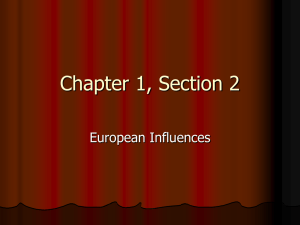
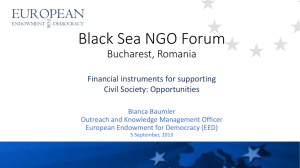
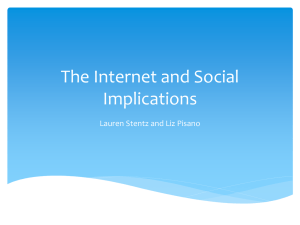
![“The Progress of invention is really a threat [to monarchy]. Whenever](http://s2.studylib.net/store/data/005328855_1-dcf2226918c1b7efad661cb19485529d-300x300.png)
